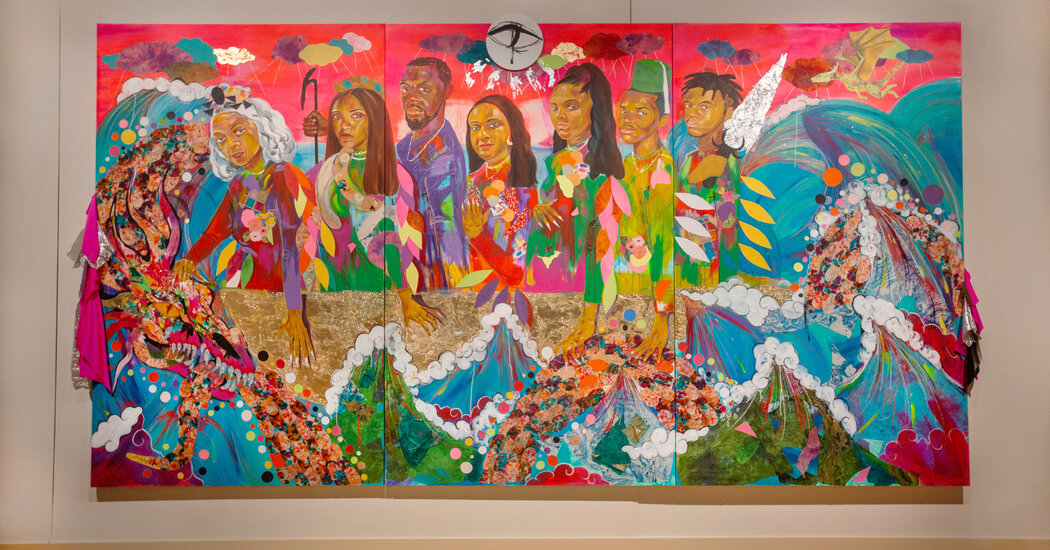
JACKSON, Miss. — Midday, midweek, in mid-90 degrees midsummer, the streets of a downtown historic district of this Southern capital are all but empty. They’re like a film set, perfect in period detail but past-use and abandoned.
A patch of sidewalk embedded with the mosaicked words “Bon-Ton Café” marks the spot of what was, a century ago, Jackson’s toniest restaurant. In the nearby King Edward Hotel, built as the Edwards Hotel in 1923 for travel swells, later a gathering spot for blues musicians, then derelict until a recent revamp, foot traffic is sparse. Across from it, trains regularly rumble into a Georgian Revival-style Union Station, but few passengers disembark or board.
Decades ago, transcontinental trains and buses leaving the old Art Deco Greyhound depot a few blocks away, did brisk business. And some of that business came from carrying Black Jacksonians northward, eastward and westward, out of a repressive and dangerous Jim Crow South, to what they hoped would be a safer and more prosperous life in cities like Chicago, Detroit, New York, Los Angeles.
This directed dispersal of some six million people, known as the Great Migration, is generally considered to have stretched from the post-Reconstruction late-19th century to the post-Civil Rights Act 1970s. And its history gets an important update in a richly varied exhibition called “A Movement in Every Direction: Legacies of the Great Migration” at the Mississippi Museum of Art here.
A collaboration between the Mississippi Museum and the Baltimore Museum of Art, the show includes a dozen contemporary artists living across the United States. All the work, migration-themed, is new, commissioned in 2020 jointly by the museums and completed during a pandemic that brought most discretionary travel pretty much to a standstill. Some of the artists had access to detailed family histories of relocation from, or within, the South. For others, geographic paths were less easily traceable. For at least one participant, migration is personal and in progress, from north to south and to Jackson itself.
Several artists take a documentarian approach to their subject. Carrie Mae Weems, at 69 the senior figure here, is one. In a stage-like video installation titled “Leave! Leave Now!” she looks back to the grim story of her grandfather, Frank Weems, an Arkansas tenant farmer who, in 1936, was viciously assaulted by a white mob for union organizing and, only because he was left for dead, managed to survive. He made his way north on foot to Chicago and never returned home. Weems’s impassioned account of the familial turmoil his exile caused, and her call for retroactive justice in his case, constitute the exhibition’s most overtly polemical moment.
Akea Brionne, born in New Orleans in 1996 and the show’s youngest contributor, makes gentler use of archival material. Based in Detroit, she weaves photographic images of forebears who never left the South — a great-grandmother and three great-aunts — into icon-like tapestries glinting with sewn-on rhinestones. And Leslie Hewitt, a native New Yorker now living in Harlem, contributes three abstract floor pieces, each suggesting a house foundation and framing delicate pieces of glassware inherited from her grandmother who spent her life in Macon, Ga.
The idea that vast histories are embodied in material culture — in specific, transportable things — is the essence of Theaster Gates Jr.’s installation called “The Double Wide.” The multipart piece memorializes childhood summer trips from his home in Chicago to visit family in Mississippi, where an uncle operated a candy store out of a double-wide trailer, which became a juke joint at night. Gates has turned his version of the trailer — a pair of boxy structures made from salvaged barn wood, into a personalized shrine-on-wheels to the South, stocked with canned and pickled goods, religious images and jazzy videos of gospel singing by the Black Monks, a music group he founded.
The Washington, D.C., conceptualist Larry W. Cook examines his roots in Georgia and South Carolina by photographing rural landscapes there and displaying them with vintage portraits of male ancestors going back several generations. The history he surveys yields a theme: a pattern of absentee fatherhood, chosen or forced, and one that he hopes to break with in his own practice of parenting.
Some artists extend the Great Migration’s territorial range beyond customary borders. Such is the case with Zoë Charlton, who comes from military lineage. (She was born in Eglin Air Force Base in Florida.) In a panoramic sculpture composed of flat, cutout and painted forms, she situates her grandmother’s sky-blue Florida bungalow in a landscape and mingles local palm trees with the jungle vegetation of Vietnam, where many Black soldiers saw combat.
Mark Bradford, based in Los Angeles, skips biographical reference altogether in a wall-filling text piece. His Great Migration research brought him to a 1913 advertisement in “The Crisis,” the magazine produced by the N.A.A.C.P. The ad read: “WANTED 500 Negro families (farmers preferred) to settle on Free Government Lands in Chaves, New Mexico,” as participants in a colony named Blackdom. Bradford’s mural-size piece, composed of 60 versions of the ad painted on paper, repeats its utopian invitation like a chant, but also darkens it: Much of the paper looks scorched, as if by fire.
Where Bradford grounds his take on the Great Migration in a concrete source, other artists address it, with less success, obliquely. Fantasy is the mode in a three-channel wraparound video by Allison Janae Hamilton which has the spirits of Black Floridians from the past haunting houses they once called home. A video by Steffani Jemison, featuring the Alabama-based performer Lakia Black, proposes the digital realm as a liberatory destination. And an abstract glass-and-steel sculpture by Torkwase Dyson avoids narrative altogether. Its four hollow trapezoidal components resemble a giant set of audio amplifiers, but the piece is mute.
By contrast, two of the strongest entries persuasively argue for the continuing dynamism of Great Migration as a Southern-directed phenomenon. A monumental crayon drawing, “A Song for Travelers,” by Robert Pruitt, was inspired by this Houston artist’s move to New York but pays homage to the Texas city he is leaving, long a vital destination for Black migrants.
And in a scintillating collage-painting titled “This Water Runs Deep,” the artist Jamea Richmond-Edwards depicts herself surrounded by family — mother, sister, husband, children — all sailing together in a gilded boat. There’s a back-story here. Decades ago, after Mississippi was hit by a series of ruinous floods, the Richmond-Edwards family had to leave land they owned there and head to Detroit, where Jamea was born. They never recovered their land, but the artist recently bought property near Jackson and plans to move here permanently.
She’s sure to be a welcome presence in a city that is for anyone with an interest in this country’s history and a stake in Black culture, a bounteous resource. A truth-telling Civil Rights Museum opened here five years ago. The Mississippi Museum of Art has compelling holdings in Southern-made work, some of it on view in galleries adjoining the Great Migration show, which has been organized by Ryan N. Dennis, chief curator and artistic director of the museum’s Center for Art and Public Exchange, and Jessica Bell Brown, chief curator for contemporary art at the Baltimore Museum. Work by local Jackson artists enlivens public walls. And the Mississippi Freedom Trail, marked by signs commemorating era-shaping events and personalities — runs through the downtown.
Indeed, almost all the people I saw on the street in blazing midsummer were tourists seeking out exactly such signs, the one at the site of the 1963 Jackson Woolworth’s sit-in, and the one that identifies the old Greyhound depot from which countless Great Migrators departed and at which others arrived. “A Movement in Every Direction” catches the pulse of that coming and going, which has not stopped. The beat, and the feet, go on.
A Movement in Every Direction: Legacies of the Great Migration
Through Sept. 11, Mississippi Museum of Art, 380 South Lamar Street, Jackson, Miss., (601) 960-1515; msmuseumart.org. It travels to the Baltimore Museum of Art, Oct. 30-Jan. 29.




